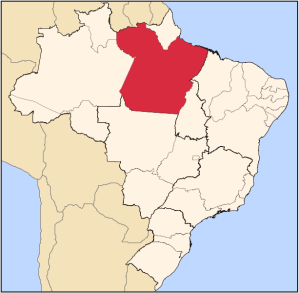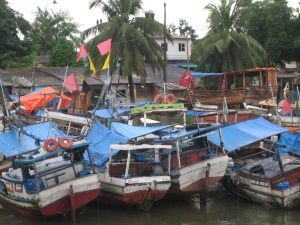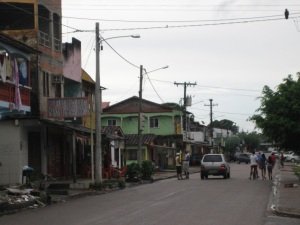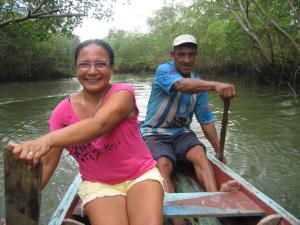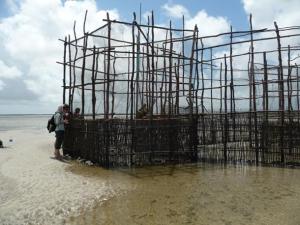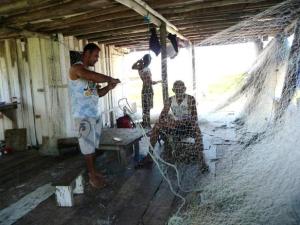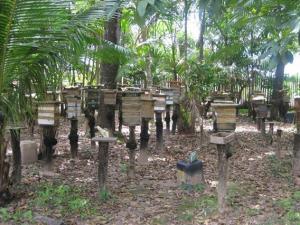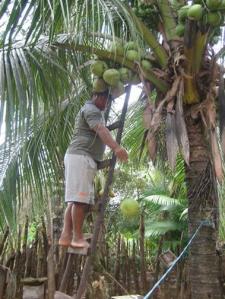Forests, fruit and fisherfolk in North Brazil’s Amazon Delta
By Claire Quinn, Steven Orchard & Lindsay C. Stringer
This blog reports on our visit to Brazil, which was supported through the University’s Fund for International Research Collaborations (FIRC). The main purpose of the trip was to consolidate research links with the Federal University of Pará (UFPA) and to jointly scope out possible study communities that we can work with in the development of a multi-stakeholder, multi-continent research proposal. The proposal links our work on coastal livelihoods, ecosystem services, institutions and governance in Asia, Africa and South America. It will be the first study of its kind to look across multiple continents. We hope you enjoy reading about our time in the Amazon Delta!
Monday
Claire H. Quinn
Monday morning was an early start to get to the international airport in Rio de Janeiro for our flight to Belem, a city in the Amazon Delta state of Pará (Figure 1).
Figure 1: Map of Brazil, with Pará shaded in red (source: Wikipedia)
We managed to beat the notorious Rio traffic as we were heading in the opposite direction from most of the Monday morning commuters! After three and a half hours we landed in Belem and made our way to our hotel in the heart of the city. Once checked in we headed out in search of food and found a food court in a local shopping mall; very similar to the ones we have at home but with a Brazilian twist. After food, and sampling local ice cream made with a fruit which tastes like a cross between banana and pineapple, we emerged to our first taste of an Amazonian thunderstorm. The amount of rain that fell was amazing and lightning flashed directly overhead, knocking out all the power. After a short wait, and the purchase of an extra umbrella, we decided to head back to the hotel so that we weren’t late for our meeting with Juarez, our Brazilian colleague from the Federal University of Pará (UFPA) who was to be our guide for the next few days. We made it back to the hotel only slightly sodden!
We met with Juarez and headed out to meet Victoria Isaac who also works at UFPA and has spent many years researching fisheries in the coastal regions of Brazil. She has a wonderful house made using local wood and full of fabulous art. We spent the evening on her veranda drinking juice made from the unusual banana-pineapple tasting fruit, eating bread and antipasti, and discussing her research. It was particularly interesting to hear about the Extractive Reserves that the Brazilian government have implemented right around the coast in Pará to protect the mangroves. In theory, an extractive reserve is a protected area in which people can live and use the land and mangroves, with a view to developing sustainable use of the ecosystem. However, the difficulties lie in implementing adequate management plans and building the capacity of local people to engage with the reserves. Although the reserves are top-down (developed by the government rather than local communities) there is some cause for optimism that they could be a force for good, allowing sustainable use of mangrove resources so that local livelihoods are supported and biodiversity is protected.
Tuesday
Steven Orchard
We awoke early in supposedly (at least, according to Trip Advisor reviews) the worst Hilton hotel in the world, to convene with our friendly host, Juarez. After breakfast, thankfully not the worst I’ve ever had, Juarez kindly took us to his beautiful home, as we appreciated the hectic traffic in Belem that he faces on a daily basis. At Juarez’s home we sampled some of the delicious produce from the variety of fruit trees in his garden before heading off to Curuça to visit local fishing communities on the Amazon Delta. The journey was interrupted by sporadic heavy rains as Juarez shared his knowledge of the local ecology and environmental issues that have been affecting the local area. We arrived at our hotel slightly surprised to find it only half finished, it apparently being renovated in anticipation of growing demand from the soon-to-be-developed new harbour. Exploring the town further and making our way to the jetty in the nearby community of Abade, we encountered friendly smiling folk, Latin music spilling from the rows of brightly coloured houses, spontaneous outbursts of dancing, and football goalposts that seemed to spring up at every corner (Figures 2 and 3). This was in stark contrast to the heavy duty iron bars fastened to the window and door of every house (theft was a major concern for the locals we were told), and the vultures that circled the harbour looking for scraps from catch from the returning fishing boats.
Figure 2: Fishing boats in Abade
Figure 3: Abade street scene
As we observed the fisher folk landing their catch of some large variety of Amazonian catfish, it was difficult not to be taken aback by the sheer scale of the river and mangrove system, the rich diversity of which provides a living to the numerous households and communities dotted around the Amazon Delta. Heading back to the hotel we found a buffet style restaurant with friendly staff who offered to cook our meals for the duration of our stay, before strolling along the promenade and witnessing the leisurely and relaxed atmosphere as the evening unfolded, a welcome break from the hectic scenes encountered in Belem.
Wednesday
Lindsay C. Stringer
We woke up on Wednesday morning and had a breakfast of bread rolls, manioc pancakes and coffee with far too much sugar in it. (Everything in Brazil seems to contain copious amounts of sugar…or cheese). The weather outside looked promising – blue skies with a few clouds. We really hoped it would stay dry after having seen the full force of equatorial rains on Monday. After meeting our community liaison contact, Gabrielle, lacquered with sun tan lotion and insect repellent, we got in the car and drove for around 20 minutes along a combination of tar and dirt roads to Candeua. Candeua is one of many communities near Curuça that is within the boundaries of the Extractive Reserve. While the reserve is a protected area in which people can live and use the land and mangroves, as Victoria had told us on Monday, implementation and enforcement was lacking.
We first visited a typical agricultural area next to a local household’s home. Compared to the African drylands I’m more used to working in, the agricultural diversity was phenomenal. For example, healthy-looking passion fruit and papayas were intercropped with chillies, while other fields were used for cassava. Surrounding trees yielded such a wide range of fruit that we sampled that I can’t remember the names of them all! Whilst in the planted area, we learned that only the green chillies were harvested and sold. Red chillies were considered worthless and given the abundance and diversity of food in the area, they were not even used for subsistence purposes.
We next went to visit another household who gave us a participatory demonstration of the stages of manioc (or cassava as it is known in other parts of the world) production and use. The male household head dug up the manioc root (it is a tuber, a bit like a potato), peeled it, and showed us how it is grated then left to soak in water. It is then put into a stretchy tube made from reeds and left to hang in the sun to dry. After the first stage of drying, it is rubbed through a reed sieve (we all had a go at that…it was amazing how soft it left your hands feeling!). The final stage was to dry it more thoroughly in a large copper pot with a fire underneath it (see Figure 4).
Figure 4: Drying the manioc flour in a big copper plated pot
Our next activity was to partake in the leisure activities of community members. We got changed into our swimwear and had a brief cool down and swim in a clean, fresh river tributary. It was definitely very welcome given the heat of the midday sun! Back at the smallholding, we were offered a huge variety of unfamiliar fruit to eat as we wandered around the land, waiting to be called for lunch. When lunch came, it was a veritable selection of rice, pasta, fish, vegetables and fruit. It was delicioso as the locals would say! We were told that nearly everything except the lettuce (and the pasta) had been grown on the household’s land or caught from the river.
After lunch, our hosts wanted to show us the mangroves and the boats they use to gather mangrove products (fish, crabs etc). The tide was in the appropriate place and so we boarded an 8-seater wooden canoe. Our hosts were in charge of the paddling while we sat back and admired the views. It was amazing to see the mangroves from the boat, particularly because they are the largest continuous area of mangrove in the world (hosting around 5% of the global mangrove resource) (Figure 5).
Figure 5: Our host family taking us on a tour of the mangroves that begin at the bottom of their garden
Throughout the day we had the chance to ask a range of different questions about land and mangrove use, as well as gaining an insight into the various social and cultural aspects of natural resource use. It was a really useful day that gave us a much deeper understanding of the similarities and differences between livelihoods in Brazil compared to those in Zanzibar and Vietnam and will be invaluable when the in-country investigators from the study countries come to Leeds in May to help us develop the full funding proposal.
Thursday
Claire H. Quinn
On Thursday it was another early start, so after the usual breakfast of bread, manioc pancakes and strong sweet coffee, we met with Nelson who was to be our guide for the day. Nelson has lived in Curuça all of his life and has done most kinds of fishing, from open water to shrimp and crab fishing. He also represented fishermen’s interests in local politics. We headed to Abade where we picked up our hire boat, a small wooden craft used to transport people across the river to villages on the islands. We set off into a beautiful sunny day following the river down towards the sea and the fishing areas. The banks were covered in thick mangrove forests and lined with fishing kraals used to catch fish with the ebb and flow of the tide. After an hour travelling downstream we finally pulled up alongside the largest sandbank that any of us had ever seen. The sand seemed to go on for kilometres, 14 km in fact! We left the captain with the boat and headed out on foot to see the kraals close up (Figure 6). They were intricately made of wood and cleverly designed to catch and funnel fish into a circular pen where they would be trapped as the tide receded (Figure 7). The fishermen would then head out twice a day on the low tide to collect the fish caught in the trap.
Figure 6: Long, hot walk across the sandbank
Figure 7: Investigating a kraal at low tide
We continued along the sandbank for another long and hot 2 km, passing kraals and long nets staked across the sand (also designed to catch fish on the tide) before we reached the fishing hut and the fishermen we had come to see. It was a welcome sight and provided some escape from the intense sun we’d had to walk through with no shade except that from our sun hats. Throughout the winter season small teams of fishermen spend up to a week at their huts. They fish, fix their nets (Figure 8) and then store their catch on ice in polystyrene boxes, before heading back into town to sell their catch and collect supplies before heading back out to their huts again. This seasonal fishing forms an important part of their livelihood strategy, which also includes fishing using kraals and collecting crabs from the mangroves during the rest of the year. The fishing huts had beautiful views of the beach and the Atlantic coast, but felt incredibly remote (Figure 9).
Figure 8: Fixing nets at the fishing hut
Figure 9: View of the Atlantic Ocean from the fishing hut
After a lunch of fresh grilled fish expertly prepared by our hosts we headed back upstream to stop off at a large island covered by a unique forest. The forest covers about a thousand hectares and has recently been found to be a unique habitat, combining characteristics of Amazonian rainforest and Brazilian Atlantic forest. We managed to walk about half an hour into the forest, wading through flooded tracks and accompanied by the rumblings of an Alouatta monkey whose calls can travel over 5 km through dense forest (Figure 10). This forest is also part of the Extractive Reserve but there are hopes to increase its protection given the unique habitat it contains.
Figure 10: Walking through a unique forest on one of the Amazon Delta Islands
We eventually headed back to the boat, slightly sunburnt, slightly muddy and very tired, for the final leg back to the harbour in Abade. It had been a long day, but we’d gained valuable insight into fishing livelihoods in the area and also the globally important habitat that supports those livelihoods. After welcome showers we headed to our now regular restaurant for dinner and discussion. By 9pm we were all in bed, fast asleep!
Friday
Lindsay C. Stringer
We got up later, around 8 am today; a deliberate move given that Thursday night was the last proper sleep we were going to get until arriving back in Leeds on Sunday evening. Flight connections from northern Brazil to the UK aren’t designed to be easy or speedy it seems! After a leisurely breakfast, we packed up the car, checked out of the hotel and drove to Abade to see a man about bee – stingless bees in fact. He had been working with the Peabiru Institute in developing a programme of beekeeping and was considered an important community innovator, being keen to experiment with stingless bees with a view to developing honey production. We saw his many bee hives, all made of wood and perched upon wooden poles (Figure 11). When he took the lid off the first hive to allow us to sample the honey, it was difficult to quell the reflex reaction you get to waft the bees away, even though you knew that they wouldn’t sting you. The honey was lovely – not too sugary and much runnier than usual (though that could be down to the heat, as once again it was more than 30 degrees by 10 am).
Figure 11: Stingless bee hives
After the hives, we visited our bee man’s house as he wanted to show us the fish (tilapia) he was rearing in a pond in his back garden. He cut down a green coconut for us each (Figure 12) and we all enjoyed some fresh coconut water and admired his other animals – chickens and an itchy pig that kept pork scratching itself on the fence of its pen.
Figure 12: Fresh green coconut harvesting
After we’d met all the family and learned about their future plans to expand fish production in another plot of land, we boarded the car and travelled back to Belem. Our drive was punctuated with a number of pit stops in order for Juarez to buy various fruit, nuts, vegetables and cheeses that aren’t widely available in Belem’s markets. The bag of lychees we consumed on the way to our lunch stop proved to be very tasty! As we got closer to Belem, the rains came and the visibility was terrible. There was lots of standing water on the road, and lots of spray from passing vehicles. After Juarez had dropped off his many purchases at his house on the outskirts of Belem, we went into the centre to meet with João, the director of an NGO who had long-term community relations in Curuça, having researched and worked there for more than ten years. João was really keen for his NGO to collaborate with us in the further elaboration of our research proposal and provided us with a lot of other useful stakeholder contacts as well. His extensive environmental education experience, as well as awareness raising and implementation of Local Agenda 21 (one of the 1992 World Summit on Sustainable Development’s main routes towards decentralised sustainable development) means he is very well placed to advise us on where the knowledge needs are in the community and to provide us with the wealth of existing data and information based on his previous work. It’s a collaboration we look forward to exploring further.
After our meeting, we went for a lovely dinner at one of Belem’s most historic restaurants. A live black soul samba band serenaded us over the internal PA system as we dined on the veranda overlooking the river. Occasional lightning strikes hit the water as another storm passed. We were confused as to why the river seemed to be flowing inland, but apparently the tidal influence extends over 700 km upstream in the Amazon!
Dinner over, we headed back to Juarez’s house for a quick shower before returning the hire car to the airport and waiting to board our 02.20 am Belem-Sao Paulo flight. We arrived in Sao Paulo 06.00 am on Saturday morning feeling rather tired but very satisfied with the insights that our visit had provided.
Saturday
Steven Orchard
We arrived at Sao Paulo airport at 06.00 am, somewhat jaded and anxious for the coming 14 hour transit until our connecting flight. After recuperating over breakfast, we found a suitable quiet corner to sit and wait out the hours…which passed surprisingly quickly. Following an on-time connection in Amsterdam, we eventually arrived back in Leeds on Sunday evening. It had been an incredibly useful trip that allowed us the chance to meet some very friendly, helpful and knowledgeable people.
We’re all looking forward to the workshop we’re hosting in Leeds in May at which we’ll be finalising the main content of our research proposal together with the co-investigators from Brazil, Vietnam and Zanzibar. We really hope it receives funding support as the Amazon Delta (like all of our other study sites) is an amazing place that is facing some very complex and challenging natural resource management issues. It would be great to have the chance to go back and to make a difference there through our research.

